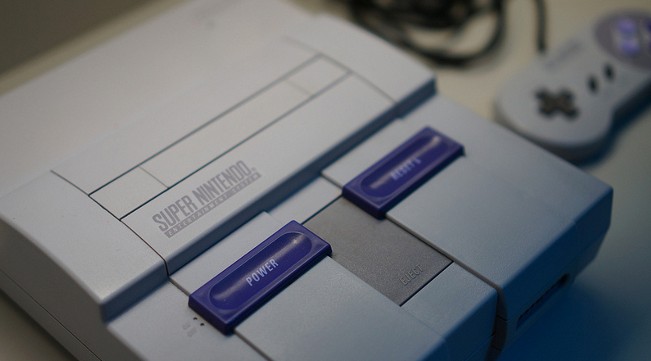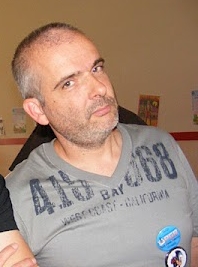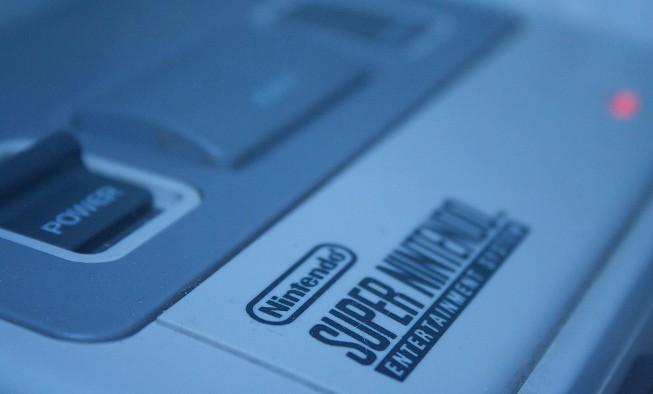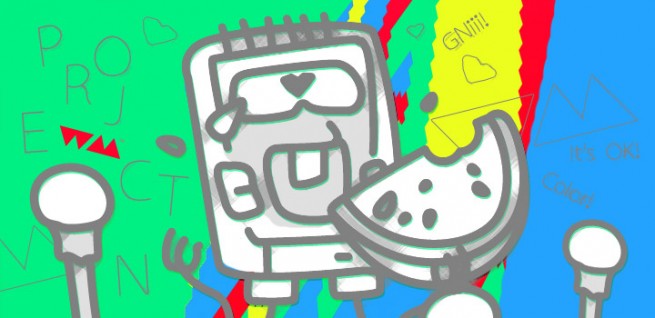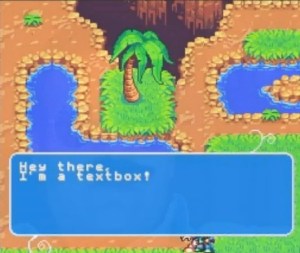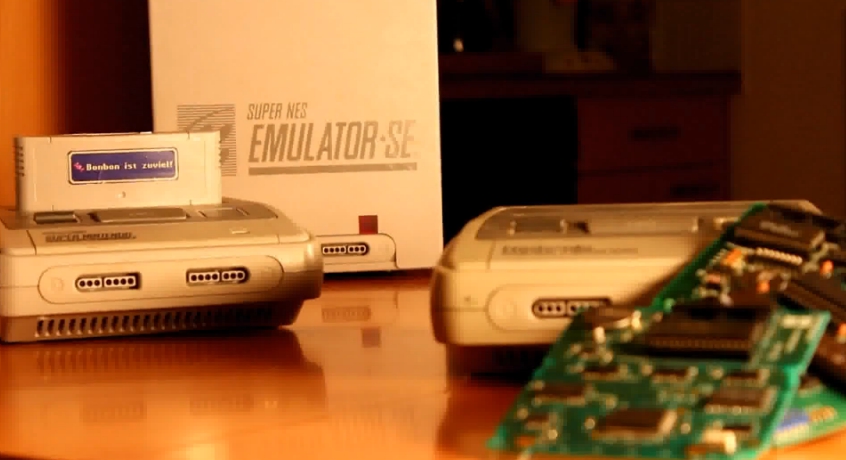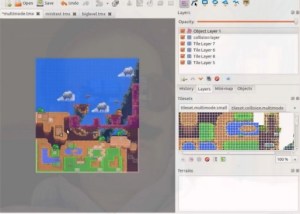Read more:
Consoles
that won’t die
For many gamers of a certain age, the Super Nintendo Entertainment System, or SNES, represents all that is good about their hobby.
Despite being 22 years old, the console remains timeless, with a lively second-hand market and committed playing community.
This year the SNES will go one step further, though, as it is receives two new boxed cartridge releases. Nightmare Busters is a lost gem that retro publisher Super Fighter Team is resurrecting, and Project N is a completely new game from WaterMelon Games of Muscatine, Iowa.
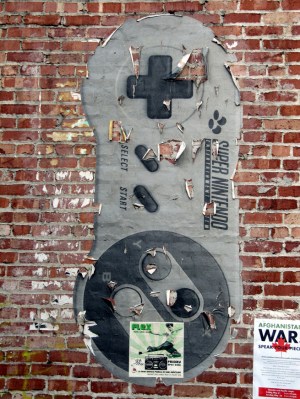 The 16-bit console wars
The 16-bit console wars
Released in North America in 1991, the SNES was Nintendo’s answer to Sega’s 16-bit Genesis. The head-to-head battle between these two consoles, and their respective mascots, Mario and Sonic, would define a generation of gaming.
Despite going up against an already established machine, the SNES could eventually declare victory in the 16-bit console war, shifting 49.1 million units worldwide compared to estimated Genesis sales of 29.5 million.
With the SNES bringing us the first installments of classic Nintendo series such as Super Mario Kart, Pilotwings, F-Zero, and Star Fox, many consider it as the greatest console of all time.
It’s quite fitting, then, that the SNES is seeing renewed interest from developers and publishers 14 years after Nintendo ceased its production.
Nightmare Busters
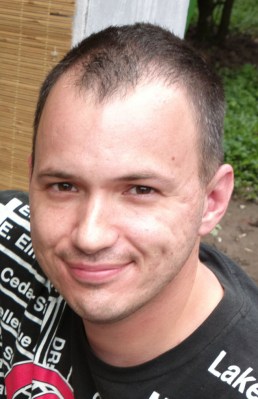
Above: Super Fighter Team president Brandon Cobb.
Super Fighter Team is a dedicated retro developer and publisher, based in Santee, Calif. Its back catalog includes releases for Sega Genesis, Atari Lynx, PC, and Mac. This year, it’s working on the SNES.
“Since our company’s founding, back in 2004, there’s been a lot of excitement about the possibility of new Super Nintendo games appearing on the market,” says Brandon Cobb, the president of Super Fighter Team. “I can’t count the number of requests that have landed in our inbox. It was about waiting for the right title to come along, because we don’t put our name on just anything.”
The right title was Nightmare Busters, a run-and-gun game originally created by French developer Christophe Gayraud in 1994. The SNES version of the game got shelved, and didn’t ever see an official release.
Arcade Zone, the studio that Gayraud was working for, fell victim to a changing gaming maket, disrupted by the Sony PlayStation. “What happened is that Sony broke off the Nintendo distribution in Europe, refusing to take the product,” explained fellow developer Carlo Perconti to 1UP.com. “Without buyers and incapable of publishing them by ourselves, we had to close down Arcade Zone and interrupt undergoing developments, with profound regret. Other companies … survived and moved on to the PlayStation. We were at the wrong time at the wrong transition, the one which saw Nintendo’s European market become Sony’s European market. “
In the intervening years, Nightmare Busters has appeared as an unauthorized ROM, and a few homemade cartridges containing this game have found their way to eBay. Now finally, nearly two decades later, Nightmare Busters is officially entering production, with Super Fighter Team planning a limited release of 1,200 copies, all of which have already been preordered.
Sadly, Nightmare Busters’ original creator will not see his game’s official launch. Gayraud passed away in April last year, at 46, following a heart attack.
“Christophe was one of the nicest guys I’ve had the pleasure to do business with,” says Cobb. “He was overjoyed at the prospect of Nightmare Busters finally getting an official release. Though he won’t be here with us to see it happen, I was at least able to break the news to him about the start of our preorder process. That ‘light at the end of the tunnel’ announcement meant a lot to him.”
What the heck is a Lynx cartridge?
Super Fighter Team has a long history of publishing games on “forgotten” consoles. Founded in 2004, the company is responsible for the localization and release of Sega Genesis role-playing games Star Odyssey, Legend of Wukong, and Beggar Prince. It also published the 2009 Atari Lynx horizontal shooter Zaku from developer PenguiNet.
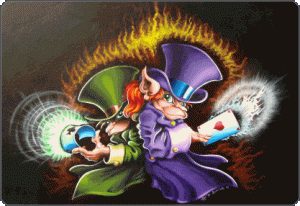
Cobb explains how tricky manufacturing authentic-looking cartridges is on consoles that have long ceased production. “One of the harder things is getting the plastic casing for the game boards,” he says. “For the Genesis, you can at least rely on an existing mold. When we did Zaku for the Lynx, however, our factory in China was like, ‘What the hell is this?’ because the Lynx is completely unknown over there. I had to send them an original game card by Atari so they could reproduce the case design to a T.”
As for publishing rights, it seems that the console manufacturers no longer care much for their old machines. “We contacted Sega of Japan ourself, in regard to publishing games for the Genesis,” says Cobb. “They don’t offer official developer licenses for the machine anymore, so they just told us not to use any of their trademarks on the products.”
Cobb won’t give a release date for Nightmare Busters yet, but it will ship sometime this year. “As soon as the official release date is confirmed,” he says, “it will be announced on our website and company Facebook page as well as by e-mail to all of our preorder customers and mailing list subscribers.”
So will it be worth the 19-year wait? Cobb says yes. “It embodies what all the top Super Nintendo games are: vibrant works of art.”
You can watch Gayraud playing Nightmare Busters in the video embedded below. It’s in French:
The state of SNES development
Evan Gowan knows a thing or two about the SNES. Running the SNES Central website and forum, he has seen and heard about most recent developments on the system.
“Nightmare Busters is kind of a unique case,” says Gowan, “as it was an essentially complete game that was produced with official tools during the 1990s. You won’t find many homebrew projects that reach its scope anytime in the near future.”
Gowan is little concerned about the final version of Nightmare Busters, having previously played the leaked prototype. “I don’t know if Super Fighter Team fixed some of the gameplay issues with the game,” he says. “The A.I. in the prototype was extremely unbalanced and led to many deaths that were not possible to avoid.”
Brandon Cobb remains tight-lipped about any changes to the game, and the question that Gowan poses remains unanswered for now. “We’ll make that announcement [about alterations from the previous build] to our customers directly before we make it to the press,” says Cobb.
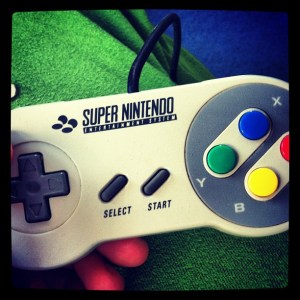 The SNES is really lagging behind other retro consoles when it comes to contemporary releases, but this doesn’t surprise Gowan. “The homebrew scene for the SNES isn’t really that advanced,” he says. “There are few tools available to aid in development, meaning that you have to do most things in assembly code. You won’t find many people tackling that today, especially given the ease of doing SNES-style games for systems like the Game Boy Advance.”
The SNES is really lagging behind other retro consoles when it comes to contemporary releases, but this doesn’t surprise Gowan. “The homebrew scene for the SNES isn’t really that advanced,” he says. “There are few tools available to aid in development, meaning that you have to do most things in assembly code. You won’t find many people tackling that today, especially given the ease of doing SNES-style games for systems like the Game Boy Advance.”
Gowan says that the SNES architecture, along with a lack of available documentation, have been really restrictive when it comes to producing new titles. “Determined programmers have done a few demos, but making full games is fairly difficult without a team,” he says.
Luckily, a team of developers is doing exactly that.
Project N
Independent game studio WaterMelon Games is looking to prove that SNES development is not only still possible but that it can also be commercially successful. A small but dedicated development team, with acclaimed 2010 Sega Genesis release Pier Solar already under its belt, WaterMelon is now taking on the SNES.
The studio is taking a unique approach to development with its Magical Game Workshop, allowing the community to “buy in” to the decision-making process. For Project N, that first, biggest, decision was to target the Super Nintendo.
“When the Magical Game Factory went live, it was a blank slate,” said WaterMelon president Tulio Adriano and Creative Director Gwenael Godde. “It could turn to be anything. The first project, Project Y, started with a poll to select the platform. There were many choices, including Xbox and PC, but the poll finished with Mega Drive as the winner. Super Nintendo was second place”
Project N, however, saw the Super Nintendo coming out on top. “Listening the voice of our customers, we booted Project N as a Super Nintendo game,” say Adriano and Godde.
Decisions have since been made about the genre, art style, and even the cartridge design of Project N. With such a creativity democracy, is there anything in place to stop the game going awry? “Although the members make the decisions,” say Adriano and Godde, “it’s still WaterMelon that provide the polls, the questions, and the answers. We give a wide range of options, but we also are careful enough to create options that make sense with the previously answered polls. In that way we can be sure we won’t have a game that ends up a disaster.”
Problems, problems, problems
The WaterMelon team is acutely aware of the difficulties in coding for the SNES. “Fortunately, we are working with a talented SNES programmer,” say Adriano and Godde. “The SNES is not exactly known as an easy platform to develop for. However, it’s a trade for more graphical modes, more colors, et cetera.”
“We have been working on a technical demo that shows all the features we needed, such as scrolling and sprites, to ensure all was mastered,” say Adriano and Godde. “Now we are working on the final game code, all made from scratch!”
A February update video from WaterMelon discussed the development process and revealed that half the programming work is already complete. It also clarified some of the unique difficulties in working with the SNES. Speed is the most important issue as the SNES’ central processing unit (CPU) is not the fastest. For every flexibility built into the game design, there is a speed penalty incurred. Programming therefore becomes a balance between having flexibility and maintaining speedy code.
The amount of data one can upload to the SNES’ graphics RAM is also quite limited. Scenes in a game must be carefully balanced, ensuring there is never too much animation happening on-screen.
Like Cobb, the team at WaterMelon has found producing authentic cartridges one the biggest challenges in retro publishing. “There are no more factories that mass produce cartridges like in the ’90s,” say Adriano and Godde. “Not the PCBs, not the cartridge shells, not the boxes … not even the classic gamebit screws. Nothing! We had to start from zero, create molds for the plastic pieces, find a factory that was able to manufacture the screws, create a new PCB design to work with the electronic parts of today. It was an odyssey. But now, thanks to that, we developed our process and it will be much easier bring in new systems such as the Super Nintendo.”
Grand ambitions
WaterMelon is not a company that takes the easy option. The same Project N development video revealed that custom hardware will be included in the game cartridge. Quite what secrets the Project N cartridge will hold remains a mystery for now, but WaterMelon is nothing if not ambitious.

Above: WaterMelon Games president Tulio Adriano [left].
“Jumping into the new platforms gives WaterMelon the chance to communicate with new players,” say Adriano and Godde. “Those that didn’t have the chance to be around when the 16-bit console were at their peak. It also lets us refresh a bit and explore what the newer technology can offer us. This exchange lets us be able to bring old concepts back to new machines, and, why not, new concepts to the old machines. Online gameplay on Mega Drive? Why not?”
Does this move toward modern platforms mean that WaterMelon will be backing off retro projects in the future? Far from it.
“Although retro style was somewhat the new trend of last year and now retro is becoming old again, our products are still distinct in the market because they’re not just games that run on emulators. They’re the real thing, with real feel. You can put them side by side with your old games and they will blend in seamlessly.”
“It really seems that there are still a lot of people that have their old consoles hooked up to their TV’s and are wanting to play new titles, and we’re here to help them do that.”
North American SNES image via adamdachis/Flickr, SNES graffiti image via loozrboy/Flickr, SNES controller image via joshhua/Flickr Ian Muttoo/Flickr, European SNES close up via Fjölnir Ásgeirsson/Flickr, Christophe Gayraud image via RetroGameSpace, Brandon Cobb and Nighmare Busters images via Super Fighter Team, all WaterMelon images via WaterMelon and WaterMelon/YouTube.
VentureBeat's mission is to be a digital town square for technical decision-makers to gain knowledge about transformative enterprise technology and transact. Learn More
